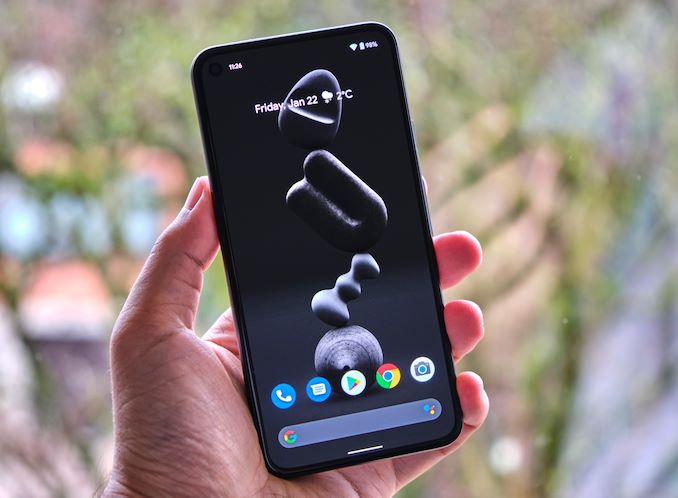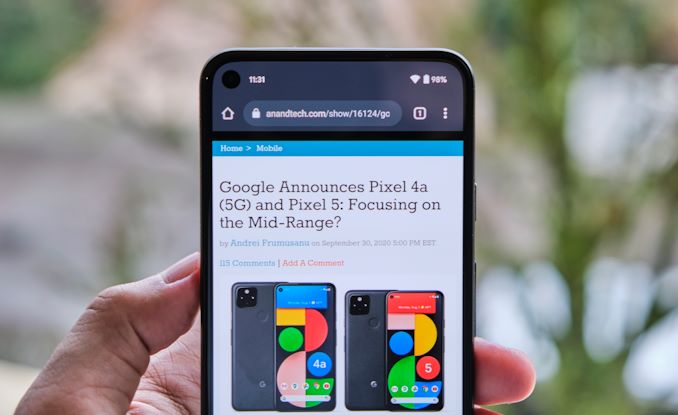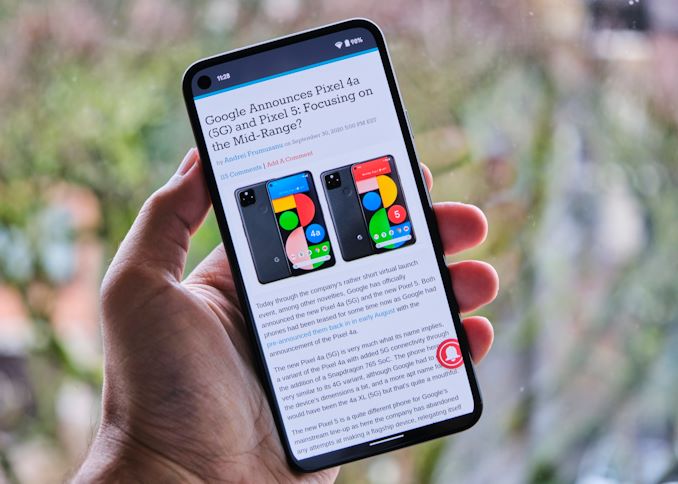The Google Pixel 5: A Mini-Review - Small Package, Small Value?
by Andrei Frumusanu on January 22, 2021 9:00 AM EST- Posted in
- Smartphones
- Mobile
- Pixel 5

It’s been a couple of months now since Google announced the Pixel 5 – Unfortunately we didn’t quite get to a timely review of the device due to other important industry coverage. Today I wanted to revisit the phone in a briefer format review, revisiting some important aspects of the phone such as performance, battery life, and add a few comments about the camera capabilities.
The Pixel 5 is a change of tactic for Google, with the company opting to go the route of a lower-cost “premium” or high mid-range component configuration, rather than setting up the Pixel 5 as an all-out flagship phone. Given the company’s product release cadence over the years, always releasing new phones towards the end of the year, just around the corner of the spring next-gen releases. This schedule had always been a disadvantage for Pixel flagships, so maybe Google’s change of strategy here to go for the mid-range is a more sensible approach.
| 2020 Google Pixels | ||||
| Pixel 4a | Pixel 4a (5G) | Pixel 5 | ||
| SoC | Snapdragon 730G 2x CA76 @ 2.2GHz 6x CA55 @ 1.8GHz Adreno 618 |
Snapdragon 765G 1x CA76 @ 2.4GHz 1x CA76 @ 2.2GHz 6x CA55 @ 1.8GHz Adreno 620 |
||
| DRAM | 6GB LPDDR4X | 8GB LPDDR4X | ||
| Storage | 128GB UFS 2.1 | 128GB | 128GB | |
| Display | 5.81" OLED 2340 x 1080 (19.5:9) |
6.2" OLED 2340 x 1080 (19.5:9) |
6.0" OLED 2340 x 1080 (19.5:9) 90Hz |
|
| Size | Height | 144.0 mm | 153.9 mm | 144.7 mm |
| Width | 69.4 mm | 74.0 mm | 70.4 mm | |
| Depth | 8.2 mm | 8.2 mm | 8.0 mm | |
| Weight | 143 grams | 168g (sub-6) 171g (mmWave) |
151g | |
| Battery Capacity | 3140mAh (typical) 18W Fast Charging |
3885mAh (typical) 18W Fast Charging |
4080mAh (typical) 18W Fast Charging |
|
| Wireless Charging | - | - | Yes | |
| Rear Cameras | ||||
| Main | 12.2MP 1.4µm Dual Pixel PDAF f/1.7 77° lens with OIS |
|||
| Telephoto | - | - | - | |
| Wide | - | 16MP 1.0µm f/2.2 107° Ultra-Wide Angle |
||
| Extra | - | - | - | |
| Front Camera | 8MP 1.12µm f/2.0 84° lens; fixed focus |
|||
| I/O | USB-C 3.5mm headphone jack |
USB-C | ||
| Wireless (local) | 802.11ac Wave 2 Wi-Fi Bluetooth 5.0 LE + NFC |
|||
| Cellular | Snapdragon LTE Integrated X15 (LTE Category 12/5) DL = 600Mbps UL = 150Mbps |
Snapdragon 5G Integrated X52 (LTE Category 18/13) DL = 1200 Mbps UL = 150 Mbps (5G NR Sub-6 + mmWave*) DL = 3700 Mbps UL = 1600 Mbps *excludes non-mmWave model of 4a(5G) *excludes mmWave in non-US markets |
||
| Other Features | Dual Speakers | Dual Speakers | Dual Speakers IP68 Rating |
|
| Dual-SIM | 1x nanoSIM + eSIM | |||
| Launch Price | $349 / 349£ / 349€ |
$499 / £499 / €499 $599* (mmWave) |
$699* / £599 / €629 |
|
Starting off with the SoC, as we’ve discussed it over the last few months, the big difference for the new Pixel 5 is that it comes with a “premium” range Snapdragon 765 chipset from Qualcomm, rather than using the contemporary Snapdragon 865 flagship SoC. This is undoubtedly a cost-cutting measure for Google to be able to achieve this new price point of $699 / €629.
The SoC should still be plenty performance for every-day usages thanks to the two Cortex-A76 big cores, with one of them clocking up to 2.4GHz and the other one at 2.2GHz, however it’s still going to be a notable downgrade compared to the flagship SoCs which employ both newer CPU cores as well as clocking them higher. The SoC’s Adreno 620 GPU is also going to be a key factor in the general performance of the Pixel 5, making some big gaming performance compromises that we’ll cover in more detail in the GPU section.
Google dons the Pixel 5 with 8GB of LPDDR4X memory and a singular storage option of 128GB, without any expandable storage.
The Pixel 5’s front design adopts the similar uniform bezel design introduced with the lower-cost Pixel 4a, and is a departure from the chin and forehead style of the previous generations, also avoiding the usage of odd camera notches. Instead, we have an in-screen camera cut-out in the top left corner, which works quite well. It’s definitely a much more modern design that we’ve seen in previous generation Pixel phones.
The actual display is a 2340 x 1080 OLED screen with a 90Hz refresh rate. This year, I’ve not seen any issues with the display panel as it’s quite high quality even though the specifications aren’t exactly up to par with 1440p 120Hz competitors.
At 6.0” diagonal and only 70.4mm phone width however, the 1080p resolution isn’t an issue as the pixel density is very viable.
The camera setup on the Pixel 5 is quite simple, but Google made some important changes in the secondary module compared to last generation, replacing the dedicated telephoto module with an ultra-wide camera. It’s always possible to pinch-to-zoom to get closer to your subject (although with quality drop), however it’s not possible to pinch out to get a wider field of view if you don’t have the camera hardware for it. This was a large criticism of the previous generation Pixel phones as they had been the only relevant devices in the market not actually using a UWA module. The camera here is a 16MP 1.0µm unit with an f/2.2 aperture and a 107° FoV – not the widest out there, but still plenty competitive and very usable.
The main camera module continues to be a 12.2MP 1.4µm sensor module with f/1.7 optics and OIS – it’s the same module we’ve seen in the Pixel 4 and an overall camera formula we haven’t seen changed in many generations of Pixel phones. Google this year advertised improvements in the HDR algorithms – although you can’t say that the overall camera experience is as ground-breaking as it was a few years ago.
The one regard where the Pixel 5 really differentiates itself from almost any other contemporary phone in the market is its build materials and build-quality. Unlike the usual glass sandwiches of recent years, the Pixel 5 uses an aluminium unibody. It’s not naked aluminium as it has a special plastic coating on it, which gives it a grippy feel, but also isn’t exactly the same as a full plastic phone.
The special thing about the aluminium body is that Google still managed to employ wireless charging though a cut-out in the frame, which of course is invisible to the user due to the plastic coating on top of it.
Generally, I found the design of the Pixel 5 to be pretty good and it had excellent ergonomics. It’s very rare to have good small phones nowadays, and at only 70.4mm width and 151g weight, the Pixel 5 does quite well to address this part of the market. Google opted not to release a Pixel 5 XL this year, so you don’t really have a choice if you prefer a larger variant of the phone – you’d have to go with the Pixel 4a XL, or another competitor device.













104 Comments
View All Comments
Jon Tseng - Friday, January 22, 2021 - link
>It’s been a couple of months now since Google announced the Pixel 5 –>Unfortunately we didn’t quite get to a timely review of the device due to
>other important industry coverage.
lol Anandtech's "it'll be ready when its ready" approach to deadlines is one of the most endearing features of the site
On that note has an Ampere/RTX3080 review on up yet? Obviously a somewhat hypothetical purchase but would be int to hear the view..
erple2 - Saturday, January 23, 2021 - link
Interestingly, maybe Anandtech is right to not actually post a review of the effectively unavailable RTX 30x0 GPUs. They're not available to most people anyway. Maybe Anandtech has been silently protesting the "paper" launch of the next gen GPUs? :)MattMe - Friday, January 22, 2021 - link
I've owned the original Pixel, Pixel 3 and now the Pixel 5.I really liked the approach to offering top tier devices in a smaller form factor when the original was released, and appreciated the vanilla Android experience. The cameras have been fantastic, in all scenarios, I have been honestly left astonished at what the camera can capture even in challenging lighting environments.
I dropped and broke the glass on my Pixel 3 otherwise would likely have kept it another year or so, but having had a look around I opted for the Pixel 5. One thing I noticed right away that I don't feel the charts here get across is the real world battery life. I'd consider myself a power user, but not particularly focused on heavy workloads (I don't often play games or run other demanding apps on my phone outside some image editing and music creation/production), but I have noticed 50% of my battery remaining at the end of the day quite often, whereas on my Pixel 3 (even when it was new) I would be needing to charge by the end of the day.
The screen is great, the cameras are still fantastic, the resin/plastic back feels comfortable and grippy, the size is perfect. I really have no qualms whatsoever.
My main reservation before purchasing was the CPU, I'd heard that it was a noticable downgrade to the Pixel 4 and even 3 but in reality I have not noticed this. I read reviews mentioning how you can see image processing completing when opening a picture immediately after snapping it, but I always saw that on my Pixel 3 too. If anything I feel this is quicker than the 3 over all, and I never felt CPU-bound with that device!
All this is to say, I agree with the review. :)
The price could be lower, compared to the 4a5g may not be great, but in comparison to the 4 last year as a 'flagship' I would say it is.
I'm much more pleased with the device than I expected and would happily recommend it.
MattMe - Friday, January 22, 2021 - link
That was a long one, I think I'm surprised by how it feels like an upgrade over the Pixel 3, despite many reviews talking about how it's a downgrade. I'd rather pay less if the only trade off is the CPU, which appears to be the case for the 5.BedfordTim - Friday, January 22, 2021 - link
The reason I have always ruled out Pixels is storage. For phone where one of the main selling points is photography, 128GB is not enough and expandable. I filled 160GB on my old Lumia 950.supdawgwtfd - Friday, January 22, 2021 - link
I have a Pixel 3.Unlimited cloud storage ;)
Photos only now are limited on cloud storage Pixel devices.
iphonebestgamephone - Sunday, January 24, 2021 - link
Not everyone has unlimited data ;)tipoo - Friday, January 22, 2021 - link
Hard to believe the GPU in this underperforms what was in my iPhone 7, 5 years ago. They went really low end with this chip. Now Android seems well enough tailored for low end hardware that you're not feeling it too much, but certainly with intensive apps and games you would.GC2:CS - Saturday, January 23, 2021 - link
But A10 took like 6 or 7 W at full load and throttle badly to 3.This sucks up one. You cannot directly compare those.
Spunjji - Monday, January 25, 2021 - link
I mean, you can - and you just did.This is more efficient but slower than a 5-year-old chip. It would be fair to expect something that is both more efficient and *at least* as fast, given the intervening progress with manufacturing processes. Qualcomm can definitely build such a GPU, but they're choosing not to. It's sad.